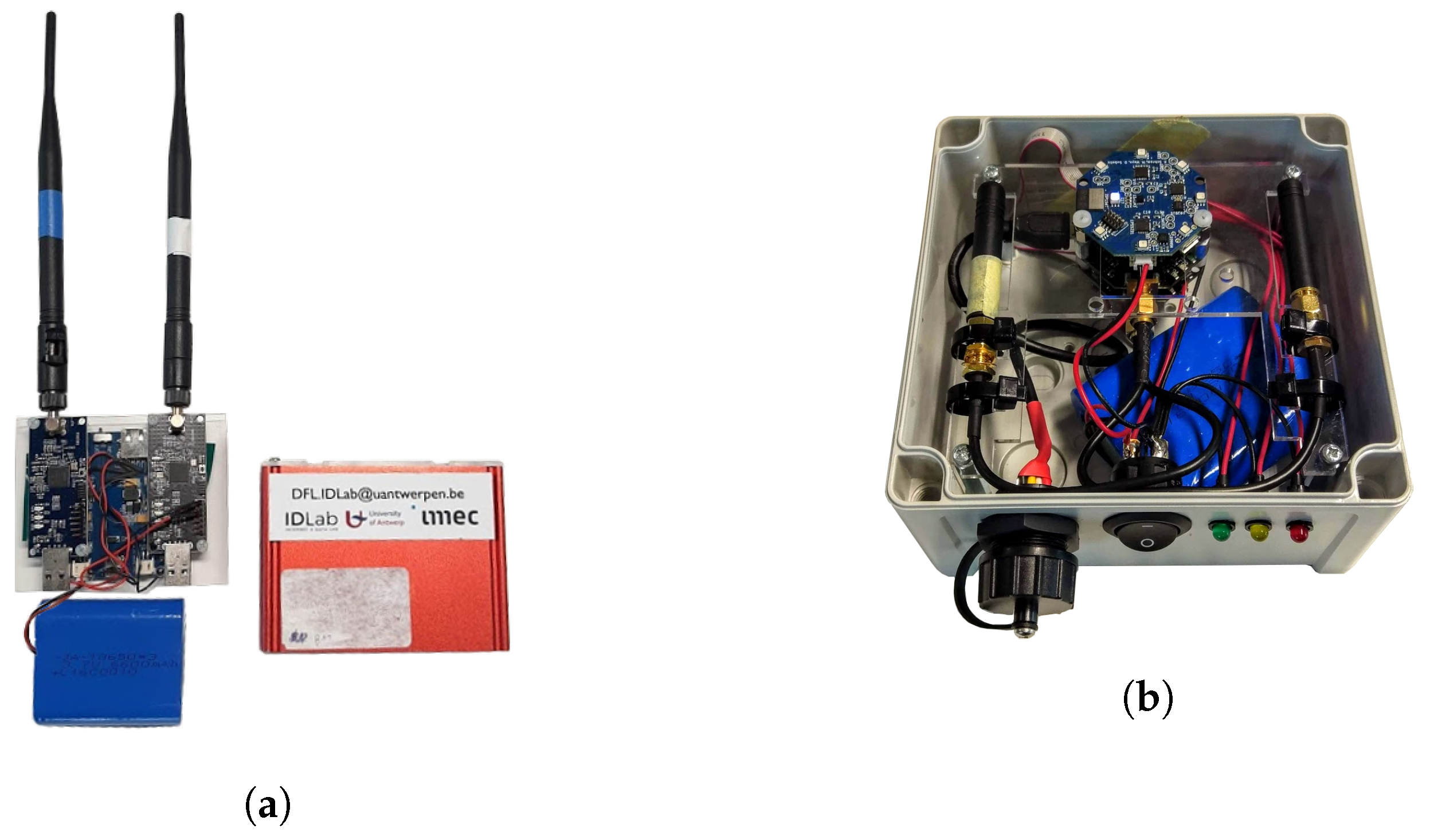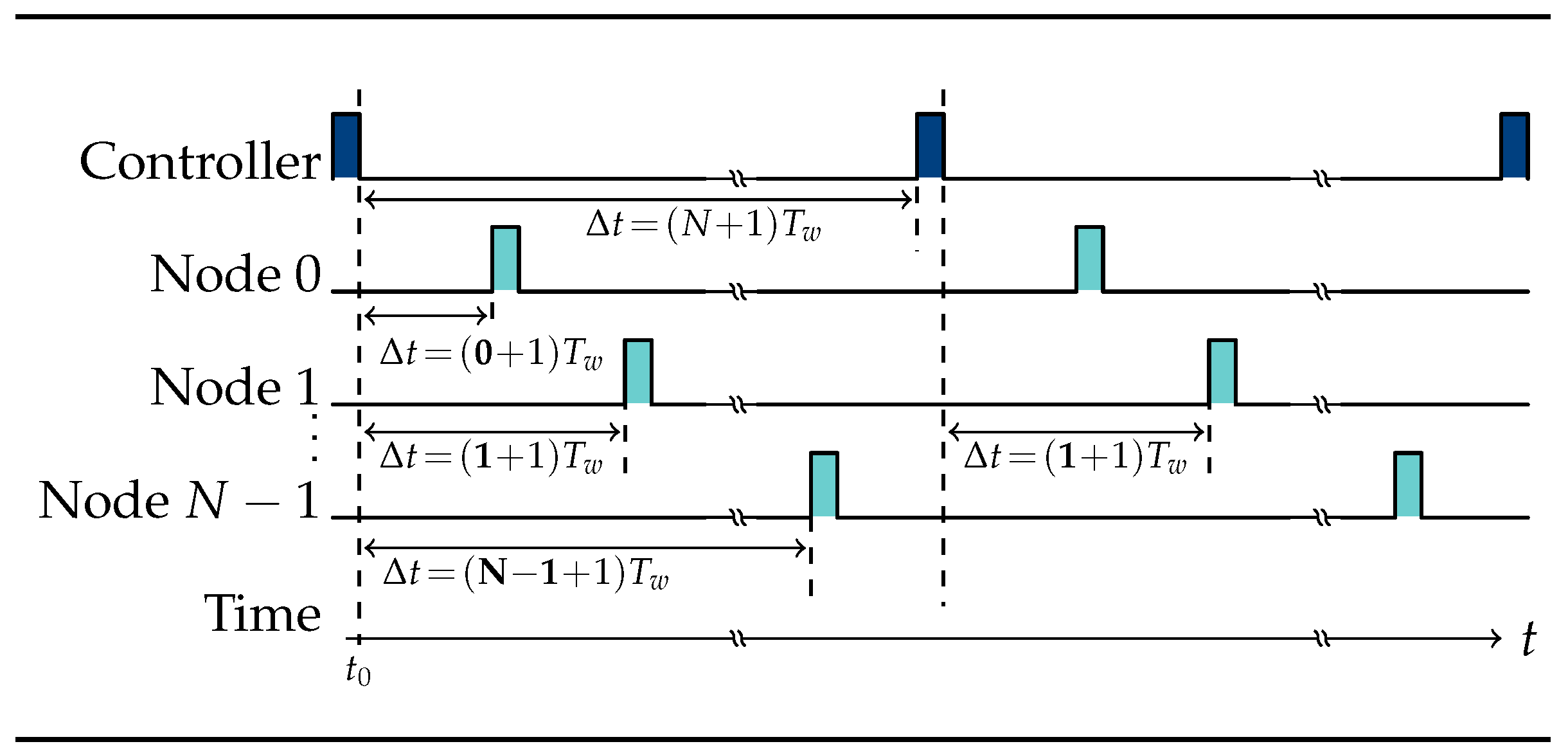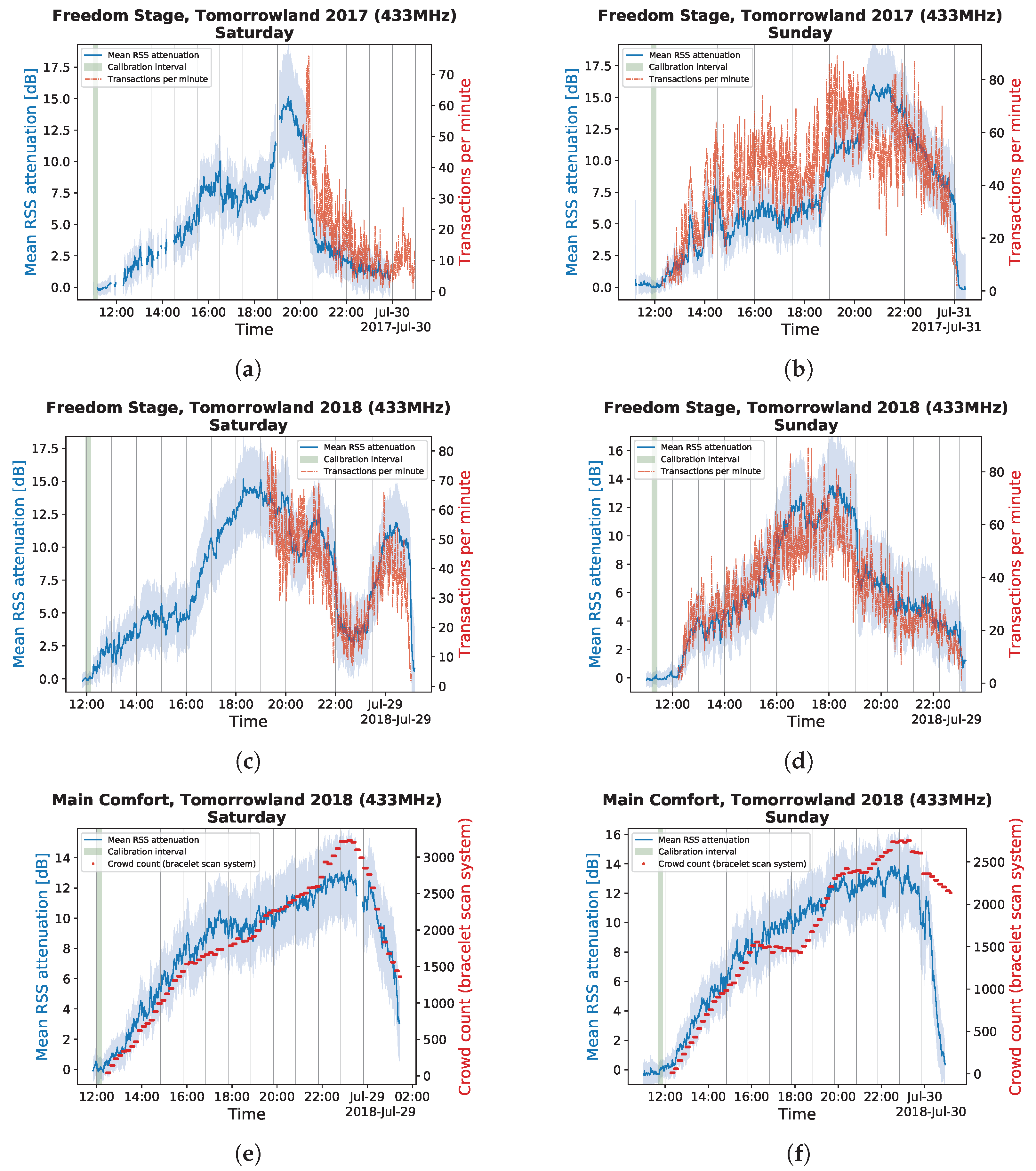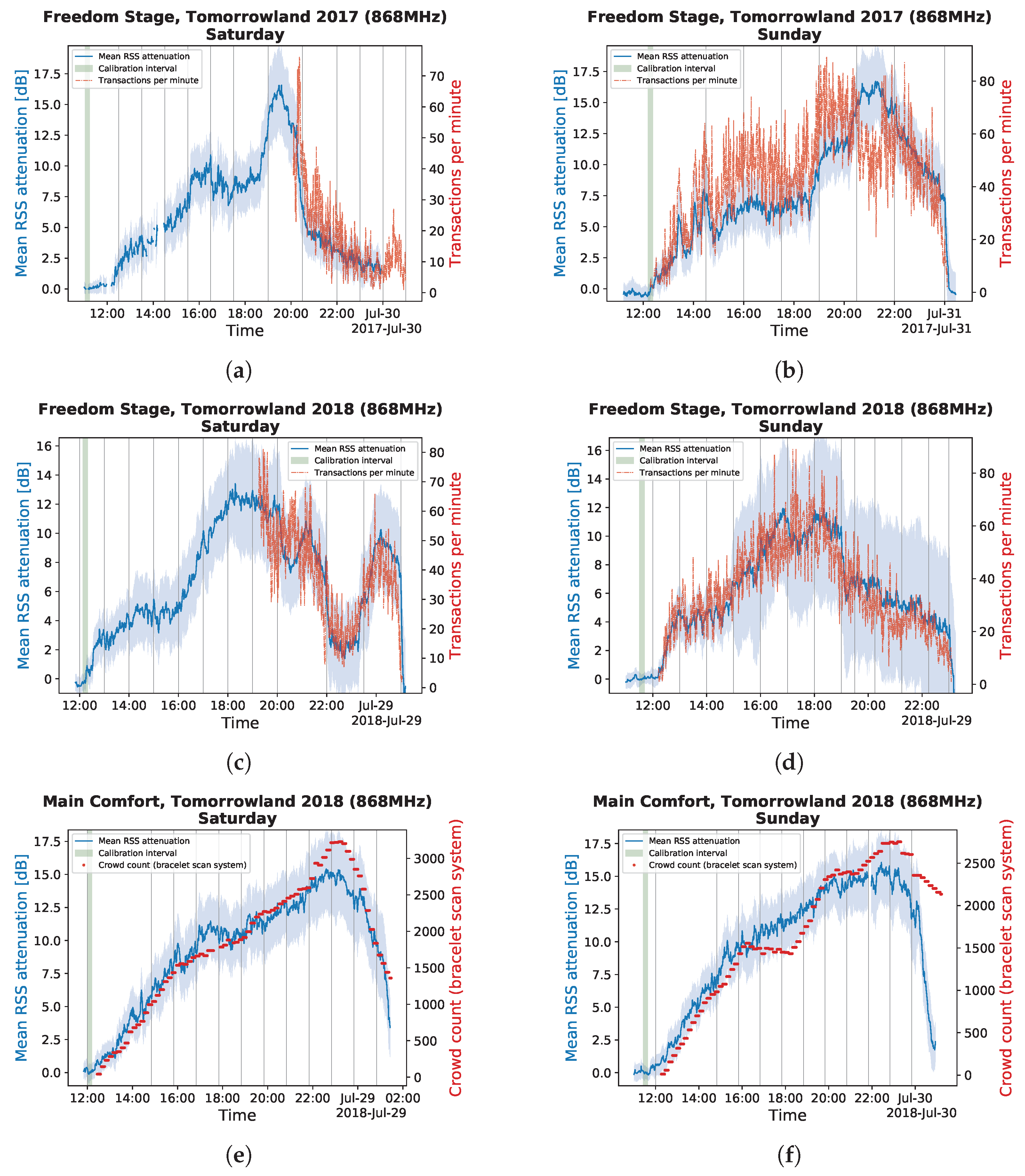Large-Scale Dataset for Radio Frequency-Based Device-Free Crowd Estimation
Abstract
1. Summary
2. Data Description
- 1.
- Dataset files: Each line corresponds to a single network node’s message, see Figure 1, and has six fields:
- ts
- String timestamp created upon receiving the message in serial form at the computing unit, so post radio reception and prior to further processing.
- node
- Number of the node ID of the transmitting node.
- band_id
- Number either 4 for the 433 MHz network or 8 for the 868 MHz network.
- cycle_id
- Number between 0 to 255 which rolls continuously. It can be used to check data continuity.
- rssi
- Number that is the RSSI (dBm) of the message as measured at the controller.
- rssi_values
- String vector, comma separated of length N containing the RSSI values as measured by the currently transmitting node when receiving the transmissions of other nodes. Although the vector consists of positive integers, the values negated and are in dBm. The vector index corresponds to the other network nodes’ IDs. This is shown in Figure 1. The input at the transmitting node’s index is always zero. Other zero entries are nodes from which the transmitting node has not received a message in the past cycle.
- 2.
- Position files: Each line is a node in the network. If an ID is skipped, it was not deployed during the measurement campaign. If a node turned out to be faulty after deployment, it is still in the positions file. The devices are placed at approximately 1 m height.
- node
- Number of the node ID.
- x
- Number for horizontal coordinate.
- y
- Number for vertical coordinate.
- 3.
- Reference files: Transactions per minute for the Freedom Stage environment and people count in the exclusive zone as estimated by the access control system for the Main Comfort environment. Each line has two fields:
- time
- String timestamp.
- count
- Number that is the reference data value (transactions or people count).
- 4.
- Line-up files: These files contain the start and stop times of performances, according to the planning. Slight deviations of true start and stop times are possible, but only in the order of minutes.
3. Methods
3.1. Hardware & Network Setup
3.2. Reference Data
4. Usage Notes
Author Contributions
Funding
Acknowledgments
Conflicts of Interest
References
- Denis, S.; Berkvens, R.; Weyn, M. A survey on detection, tracking and identification in radio frequency-based device-free localization. Sensors (Switzerland) 2019, 19, 5329. [Google Scholar] [CrossRef] [PubMed]
- Zanella, A. Best practice in RSS measurements and ranging. IEEE Commun. Surv. Tutor. 2016, 18, 2662–2686. [Google Scholar] [CrossRef]
- Torres-Sospedra, J.; Moreira, A.; Knauth, S.; Berkvens, R.; Montoliu, R.; Belmonte, O.; Trilles, S.; João Nicolau, M.; Meneses, F.; Costa, A. A realistic evaluation of indoor positioning systems based on Wi-Fi fingerprinting: The 2015 EvAAL–ETRI competition. J. Ambient. Intell. Smart Environ. 2017, 9, 263–279. [Google Scholar] [CrossRef]
- Kamińska-Chuchmała, A.; Graña, M. Indoor Crowd 3D Localization in Big Buildings from Wi-Fi Access Anonymous Data. Sensors 2019, 19, 4211. [Google Scholar] [CrossRef] [PubMed]
- Yuan, Y.; Qiu, C.; Xi, W.; Zhao, J. Crowd density estimation using wireless sensor networks. In Proceedings of the 2011 7th International Conference on Mobile Ad-hoc and Sensor Networks, MSN 2011, Beijing, China, 16–18 December 2011; pp. 138–145. [Google Scholar] [CrossRef]
- Halperin, D.; Hu, W.; Sheth, A.; Wetherall, D. Tool release: Gathering 802.11n traces with channel state information. Comput. Commun. Rev. 2011, 41, 53. [Google Scholar] [CrossRef]
- Sobron, I.; Del Ser, J.; Eizmendi, I.; Velez, M. Device-Free People Counting in IoT Environments: New Insights, Results, and Open Challenges. IEEE Internet Things J. 2018, 5, 4396–4408. [Google Scholar] [CrossRef]
- Xi, W.; Zhao, J.; Li, X.Y.; Zhao, K.; Tang, S.; Liu, X.; Jiang, Z. Electronic frog eye: Counting crowd using WiFi. In Proceedings of the EEE INFOCOM 2014—IEEE Conference on Computer Communications, Toronto, ON, Canada, 27 April–2 May 2014; pp. 361–369. [Google Scholar] [CrossRef]
- P802.11ah/D5.0, Mar 2015 - IEEE Standard for Information Technology—Telecommunications and Information Exchange between Systems—Local and Metropolitan Area Networks—Specific Requirements—Part 11 Wireless LAN Medium Access Control (MAC) and Physical; IEEE: Piscataway, NJ, USA, 2015.
- Denis, S.; Berkvens, R.; Bellekens, B.; Weyn, M. Large Scale Crowd Density Estimation Using a sub-GHz Wireless Sensor Network. In Proceedings of the 2018 IEEE 29th Annual International Symposium on Personal, Indoor and Mobile Radio Communications (PIMRC), Bologna, Italy, 9–12 September 2018; pp. 849–855. [Google Scholar] [CrossRef]
- Denis, S.; Bellekens, B.; Kaya, A.; Berkvens, R.; Weyn, M. Large-scale Crowd Analysis Through the Use of Passive Radio Sensing Networks. Sensors 2020, 20, 2624. [Google Scholar] [CrossRef] [PubMed]
- Kaya, A.; Denis, S.; Bellekens, B.; Weyn, M.; Berkvens, R. Large-Scale Dataset for Radio Frequency based Device-Free Crowd Estimation (Zenodo), May 2020. [CrossRef]
- DASH7 Alliance. DASH7 Alliance Protocol Specification v1.2. Available online: https://dash7-alliance.org/download-specification/ (accessed on 9 June 2020).
- Weyn, M.; Ergeerts, G.; Berkvens, R.; Wojciechowski, B.; Tabakov, Y. DASH7 alliance protocol 1.0: Low-power, mid-range sensor and actuator communication. In Proceedings of the 2015 IEEE Conference on Standards for Communications and Networking, Tokyo, Japan, 28–30 October 2016; pp. 54–59. [Google Scholar] [CrossRef]






| Dataset File | Reference File |
|---|---|
| free17_433_fri.csv | None |
| free17_868_fri.csv | None |
| free17_433_sat.csv | free17_transactions.csv |
| free17_868_sat.csv | free17_transactions.csv |
| free17_433_sun.csv | free17_transactions.csv |
| free17_868_sun.csv | free17_transactions.csv |
| free18_433_fri.csv | None |
| free18_868_fri.csv | None |
| free18_433_sat.csv | free18_transactions.csv |
| free18_868_sat.csv | free18_transactions.csv |
| free18_433_sun.csv | free18_transactions.csv |
| free18_868_sun.csv | free18_transactions.csv |
| main18_433_fri.csv | None |
| main18_868_fri.csv | None |
| main18_433_sat.csv | main18_counts.csv |
| main18_868_sat.csv | main18_counts.csv |
| main18_433_sun.csv | main18_counts.csv |
| main18_868_sun.csv | main18_counts.csv |
| Environment | Day | Time (24 h) | Message Counts | Reference | Area () | |
|---|---|---|---|---|---|---|
| 433 MHz | 868 MHz | |||||
| Freedom Stage 2017 | Friday | 11:00–01:30 | 393,852 | 472,202 | Transactions | 1654.52 |
| Nodes at 433 MHz: 46 | Saturday | 11:00–01:30 | 996,033 | 1,023,059 | ||
| Nodes at 868 MHz: 46 | Sunday | 11:00–01:30 | 1007,066 | 1,036,456 | ||
| Freedom Stage 2018 | Friday | 11:00–01:30 | 765,024 | 757,657 | Transactions | 1686.06 |
| Nodes at 433 MHz: 46 | Saturday | 11:50–01:30 | 711,438 | 714,390 | ||
| Nodes at 868 MHz: 46 | Sunday | 11:00–01:30 | 648,329 | 656,290 | ||
| Main Comfort 2018 | Friday | 11:00–01:30 | 791,462 | 908,407 | People count | 1252.30 |
| Nodes at 433 MHz: 40 | Saturday | 11:00–01:30 | 863,666 | 884,682 | ||
| Nodes at 868 MHz: 54 | Sunday | 11:00–01:30 | 903,862 | 894,496 | ||
| Protocol | DASH7 | |
| Channel access | CSMA-CA | |
| Data rate (normal-rate) | 55.55 kbps | |
| Occupied bandwidth | 156 kHz | |
| Modulation scheme | 2-GFSK | |
| Modulation index | 1.8 | |
| Transmission Power | 16 dBm | |
| Frequency band | 433 MHz | 868 MHz |
| Duty cycle per device | ||
| Freedom 2017 | 0.37% | 0.37% |
| Freedom 2018 | 0.37% | 0.37% |
| Main Comfort 2018 | 0.38% | 0.36% |
© 2020 by the authors. Licensee MDPI, Basel, Switzerland. This article is an open access article distributed under the terms and conditions of the Creative Commons Attribution (CC BY) license (http://creativecommons.org/licenses/by/4.0/).
Share and Cite
Kaya, A.; Denis, S.; Bellekens, B.; Weyn, M.; Berkvens, R. Large-Scale Dataset for Radio Frequency-Based Device-Free Crowd Estimation. Data 2020, 5, 52. https://doi.org/10.3390/data5020052
Kaya A, Denis S, Bellekens B, Weyn M, Berkvens R. Large-Scale Dataset for Radio Frequency-Based Device-Free Crowd Estimation. Data. 2020; 5(2):52. https://doi.org/10.3390/data5020052
Chicago/Turabian StyleKaya, Abdil, Stijn Denis, Ben Bellekens, Maarten Weyn, and Rafael Berkvens. 2020. "Large-Scale Dataset for Radio Frequency-Based Device-Free Crowd Estimation" Data 5, no. 2: 52. https://doi.org/10.3390/data5020052
APA StyleKaya, A., Denis, S., Bellekens, B., Weyn, M., & Berkvens, R. (2020). Large-Scale Dataset for Radio Frequency-Based Device-Free Crowd Estimation. Data, 5(2), 52. https://doi.org/10.3390/data5020052








